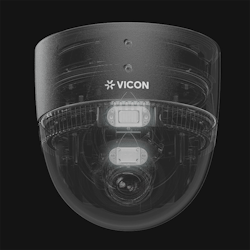This article originally appeared in the February 2025 issue of Security Business magazine. Feel free to share, and please don’t forget to mention Security Business magazine on LinkedIn and @SecBusinessMag on Twitter.
The Skinny:
- Vicon, once known for traditional CCTV, has redefined its product lineup with the modular NEXT camera system.
- The NEXT system’s modular camera design allows for up to four interchangeable camera modules, offering greater flexibility, faster installation, and the potential to reduce costs and stock requirements.
- Game-Changer for Integrators: The modular cameras can be set up in under five minutes by technicians of any skill level, signaling a major shift in video surveillance installations that could influence the entire industry.
The name Vicon conjures a company that was the leader in CCTV cameras and accessories from 1967 to the mid-1980s – not necessarily a company that is synonymous with cutting-edge in 2025; however, that perception may be on the verge of a change.
Confession time: Vicon has been a dark horse favorite of mine for the last few years since I was re-introduced to the product. Yep, I had forgotten about them (sorry, Vicon), but once re-introduced, I realized they had a solid product. Then I was introduced to the new Vicon NEXT, and to say that it is a trend-setting camera solution is probably an understatement. Like a five-star restaurant dish, it offers a unique solution to the future of a security camera, with a well-balanced and future-ready technology stack, and a simple but impressive presentation.
The product impressed me enough to dedicate this column to why modular will change the game in the video surveillance space.
Deep Product Dive
But where did this new product come from? Vicon’s leaders were honest with themselves and realized the company needed a change – something that would take them into the future. They hired an industrial design group to create a product that was useful, functional, sustainable, and elegant. With a new design in hand, Vicon then reached into its product line, pulling in the features from its most successful cameras.
“NEXT represents years of research by a consortium of experts, including integrators, installers, end-users, sales, manufacturing, operations, R&D, and more,” explains VP of Sales Jason Alestra. “The expert panel was comprised of stakeholders from key constituents, even some from outside the industry, and some who had never sold a Vicon product. We started with a clean slate, and we listened as the panel told us everything that was wrong with the surveillance cameras – everything. Our goal was to start over and re-imagine everything we held to be true about camera manufacturing, installation, stocking, pricing, and selling.”
The resulting modular camera system can include up to four camera modules. Each module contains a completely factory-sealed camera sensor for dome, bullet, or multisensor applications. It includes a Network Hub, which is a sealed PoE hub that can support up to four sensors from one network drop. The sensor module is Zigbee-enabled for communication with Internet of Things (IoT) devices.
In addition to the innovative modular design, let’s run down some of the basics: 8MP imager, vandal-resistance, AI analytics, cloud-ready and can be integrated with common enterprise VMS, 120 dB WDR, and H.264 and H.265 compression.
The 8MP sensor is a 1/1.8 image sensor – almost double the size of most 8MP cameras, possibly making it the largest and most sensitive starlight sensor on the market. It is built on the Hailo chipset, with all of the AI Analytics custom-written and running natively on the camera. One of those analytics is AI De-Noise, which takes a grainy low-light picture and automatically tunes the camera for a noise-free, color image in as low as 0.02 lux.
Its PTRZ lens positioning enables a fixed camera to act like a PTZ. While most PTRZ cameras on the market support 250-500 “rolls” over the camera's lifetime, Vicon’s camera supports 5000 “rolls” – meaning the camera can be moved twice a day, every day, through its five-year warranty and still have a lifespan to the PTRZ function. This allows the camera to be installed by anyone and set up by offsite personnel, either the integrator or the end-user.
Modular Signals Potential Industry Shift
Such modular capability is a game-changer for the security industry and is surely a tech trend. In this product’s case, it enables an integrator to create a multisensor camera using two, three, or four single sensors instead of a pre-consolidated single dome. Admittedly I had some struggles with how this would work, but the configuration enables the multisensor to be tailored to any use-case using any combination of cameras and even IoT sensors.
This all led to a product that can be fully installed in less than 5 minutes by a technician at any skill level. All it requires to be fully functional at that point is to remotely connect to the camera, and then position it to the desired field of view (FOV). One camera to do it all; one part to keep in stock.
With this introduction, I believe modular cameras will become the hottest new form factor, and others will follow in making single camera sensors that can be installed everywhere – as a single dome, bullet, or multisensor application. Integrators will find they can install it in less time with varying levels of skilled talent, with reduced truck stock, savign them money.
Once the integrator channel accepts this shift to modular systems, it will be only a matter of time before other manufacturers pivot to incorporate these concepts into their designs.
About the Author

Jon Polly
Jon Polly is the Chief Solutions Officer for ProTecht Solutions Partners (www.protechtsolutionspartners.com), , a security technology consulting firm that works with smart cities and corporations to bring business intelligence and public safety through security IoT applications. He has worked as a Project Manager and System Designer for City-Wide surveillance and Transportation camera projects in Raleigh and Charlotte, N.C.; Charleston, S.C.; and Washington, D.C. He is certified in Critical Chain Project Management (IC3PM) by the International Supply Chain Education Alliance (ISCEA). • (704) 759-6837

